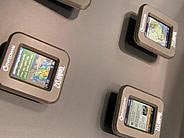Qualcomm and several other manufacturers are currently working to advance the development of a new display technology for handheld and mobile devices.
 According to developers, displays utilizing this new technology can showcase content without requiring a power source, relying solely on sunlight or the movement of the device itself.
According to developers, displays utilizing this new technology can showcase content without requiring a power source, relying solely on sunlight or the movement of the device itself.
The Difference…
As a result, a mobile phone equipped with a display using this technology can continuously show any content requested by the user without consuming any energy.
Most mobile phone screens today automatically turn off when not in use to save power. In contrast, this new display technology is illuminated by sunlight or functions through the movement of liquids within the screen.
The backlighting technique is a “battery killer,” according to Mark Gostick, CEO of Liquavista, a company specializing in liquid displays. The backlight technique can consume up to 90% of the energy supplied to the screen.
“The display consumes the most energy in a mobile phone,” stated Paul Jacobs, CEO of Qualcomm, during the launch of the company’s new iMod display.
The iMod display is essentially a complex mirror. The mobile phone generates the displayed image, which is then shown on the screen using sunlight or surrounding artificial light sources. The charge embedded in the iMod screen ensures the image is bright, clear, and full of effects.
In low-light conditions, a built-in light source will illuminate the screen. However, even then, this new display technology consumes significantly less energy than current displays, Qualcomm asserts.
The first iMod screen from Qualcomm only displays information in black and white grayscale. The company has also successfully developed a color display using this new screen technology, Jacobs confirmed.
Meanwhile, Liquavista’s displays are based on a technique called “electrowetting.” Each pixel contains water and colored oil. When a charge is applied to the pixels, it gains water-attracting properties. Water is drawn to the surface of the display, forcing the oil to surface and color the pixels. When the charge is removed, the screen reverts to being a water-attracting surface, pulling water up and pushing the oil away.
Both companies have thus perfected their technologies. The key challenge now is convincing hardware manufacturers to adopt their technologies.
Hoàng Dũng


















































